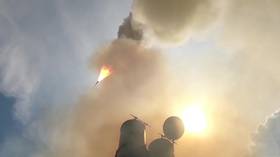Russia’s new S-550 air-defense system rolled out – TASS

RT: Russia’s new S-550 air defense system, said to be capable of hitting high-altitude spacecraft and missiles, including hypersonic types, has passed trials and is already in service, TASS has reported.
The Moscow news agency quoted a source, which it said is close to the Defense Ministry, who described the S-550 as “an absolutely new mobile strategic missile defense system, which is unparalleled anywhere in the world and capable of striking spacecraft, warheads of intercontinental ballistic missiles and hypersonic targets.”
“The S-550 air defense system has successfully completed state trials. Its first brigade has already been placed on combat duty,” they continued.
The arrival of this new hardware ensures that Russia possesses a multilayered air- and missile-defense architecture, according to the TASS source.
The country now boasts Pantsir anti-aircraft and cannon systems that cover low altitudes; the long-range air-defense systems S-350, S-400 and S-500; as well as the S-550, preventing threats from space.
There has so far been no official confirmation of the report.
The S-550 was developed in secrecy, with the public only becoming aware of its existence in early November. At that time, Defense Minister Sergey Shoigu described the state-of-the-art air-defense system as being among the Russian military’s weapons of great importance during a panel chaired by President Vladimir Putin.
Sergey Chemizov, the head of the Rostec military-industrial conglomerate, later said that the S-550 will have a larger target-detection area and a longer missile range compared to its predecessors.
Russia’s S-550 missile defense system to intercept warheads free of nuclear blast — expert
MOSCOW, November 16. /TASS/. Russia’s latest S-550 missile systems will serve as a mobile follow-up of the A-135 ‘Amur’ – A-235 ‘Nudol’ strategic missile defense system and will feature the kinetic energy interceptor principle to avoid a nuclear detonation when a warhead is struck, military expert Dmitry Litovkin told TASS on Tuesday.
This will make it possible to “physically destroy the warhead and prevent nuclear blasts,” Litovkin said.
“In the case that a warhead is destroyed, its fragments will create a radioactive background, albeit to a lesser degree compared to a shell explosion,” he explained.
“Nothing is known about the S-550 but I presume that it will become an extra element of the Prometei system. It was earlier announced that this system would be able to shoot down both ballistic nuclear warheads and low-orbit satellites. Judging by everything, the military has made a decision to divide these functions between the two systems (the multitask option is not always good for a combat system). Hence a conclusion that the S-550 will serve as a follow-up to the A-135 ‘Amur’ – A-235 ‘Nudol’ strategic missile defense system but in its mobile configuration,” the expert said.
S-550 strategic missile system
A source close to Russia’s Defense Ministry earlier told TASS that the first S-550 strategic missile defense system would enter service with the Russian Army by 2025. He said that the hardware for the S-550 had already been built and related to the strategic ballistic missile defense system. The S-550 would use a mobile launcher with a hypersonic missile and no seaborne version of this weapon was envisaged, the source said.
Head of the Russian tech corporation Rostec Sergey Chemezov said at the Dubai Airshow 2021 that the S-550 would feature a longer-range target detection and missile interception capability.
Russian Defense Minister Sergey Shoigu said at the ministry’s conference call on November 9 that at defense industry meetings in Sochi in November Russian President Vladimir Putin had put emphasis on the importance of delivering S-350, S-500 and S-550 air and missile defense systems to the Russian troops.
The S-550 short-range missile interception weapon (the project of the mobile point defense missile system) was developed in the Soviet Union in 1981-1988 at the Almaz Central Design Bureau (currently, the Almaz Research and Production Association within the Almaz-Antey Group). The work on this system was terminated simultaneously with several projects of other Soviet design bureaus in the defense sphere as part of Soviet-American agreements. The equipment of the weapon’s fire system prototype was dismantled after 1992. The groundwork created in the process of the work on the project was destroyed after the disintegration of the USSR.
ATTENTION READERS
We See The World From All Sides and Want YOU To Be Fully InformedIn fact, intentional disinformation is a disgraceful scourge in media today. So to assuage any possible errant incorrect information posted herein, we strongly encourage you to seek corroboration from other non-VT sources before forming an educated opinion.
About VT - Policies & Disclosures - Comment Policy




America has been an army on the march.
Now it has to turn and face itself.
” An army on the march has no philosophy; it views itself as a creature of the moment. It does not rationalize conduct except in terms of an immediate end. As Tennyson observed, there is a pretty strict official understanding against its doing so; “theirs not to reason why.” Emotionalizing conduct is another matter, and the more of it the better; it is encouraged by a whole elaborate paraphernalia of showy etiquette, flags, music, uniforms, decorations, and the careful cultivation of a very special sort of comradery. In every relation to “the reason of the thing,” however – in the ability and eagerness, as Plato puts it, “to see things as they are” – the mentality of an army on the march is merely so much delayed adolescence; it remains persistently, incorrigibly and notoriously infantile. Past generations of Americans, as Martin Chuzzlewit left record, erected this infantilism into a distinguishing virtue, and they took great pride in it as the mark of a chosen people, destined to live forever amidst the glory of their own unparalleled achievements wie Gott in Frankreich.”
Quote from the book Our Enemy, the State by Albert J Nock.
Curiously throughout history armies have been led into slaughter by a leadership with it’s own, strangely different, agenda.
Comments are closed.